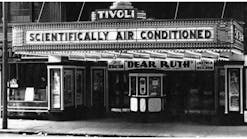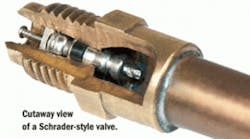Manufacturers and designers of air-conditioning, refrigeration, and heat-pump systems must determine the process that will be used for evacuation, charging, and run testing their systems. Valves and process tubes provide the necessary access to the system, but before implementing a solution users must consider the factors specific to each application, including ease-of-use, flow rate, leak rate, cost, and field-service requirements.
Within heating, piping, and air-conditioning applications, there are several commonly used methods for introducing air, liquids, and gas into the system. Options include the Schrader-style valve, high-flow valves, process tubing paired with connectors, and a valve quick-connection system. By understanding how each solution works and its benefits and limitations, users can make informed decisions about the option that best complements their specific requirements.
Schrader-Style Valves
The Schrader valve, also referred to as the American valve, is one of the most common styles used for heating, piping, and air-conditioning applications. These valves typically are used to provide production and service access ports on refrigeration systems.
A basic Schrader valve is comprised of a valve and core. Schrader valves have two potential leak paths and limited tolerance control. They feature a sleeve seal between the valve stem and the valve, with an additional elastomer seal on the valve stem. Various Schrader design styles are available to suit diverse application requirements. For instance, a stub design fits on a stub tube, saddle-mount styles fit directly on piping, and panel-mount seats are available for brazing the valve on a flat surface instead of the pipe itself.
While improvements have been made to the original Schrader valve, today’s design is very similar to the original version. Schrader-style valves are typically inexpensive, work well with a variety of pressure switches, and provide quick restrictive access to systems. However, because these valves originally were designed for low-pressure applications where small leaks and limited flow rates were not a concern, they may not provide an ideal solution for today’s high-pressure, highly engineered air-conditioning and refrigeration systems. Additionally, Schrader valves offer limited flow rates that may prove too time-consuming for process applications.
High-Flow Valves
One of the biggest challenges that heating, piping, and air-conditioning manufacturers face is finding a method to create a high-quality product while shortening the time it takes to evacuate contaminants and charge a system. Because Schrader valves may be too restrictive to provide the necessary flow rates, some manufacturers and system designers implement a valve featuring a larger flow diameter. Manufacturers also may choose to partner high-flow valves with Schrader valves, using the former only for processing in the manufacturing plant and the latter for access to the system in the field. Although high-flow valves may provide the necessary flow rates to improve takt times, they lack the compatible tooling needed at the factory level and in the field.
Connectors Used With Process Tubes
Another approach eliminates the valve altogether, with the exception of a service-only access valve. Instead, a special connector can be used to grip and seal onto a process tube, allowing much higher flow for processing. While this method increases processing flow, it has several shortcomings. For instance, after the system is charged, the tube must be pinched and brazed to be sealed. This extra step requires significant time, and it can be difficult to make the brazed joint leak-free. Because this joint is made after the system has been evacuated and charged with refrigerant, correcting a leak at this point can require the refrigerant to be reclaimed and the whole process started again.
Valve Quick-Connection Systems
With the recently mandated conversion from ozone-depleting chlorofluorocarbon (CFC) refrigerants, such as R-22, to environmentally friendly non-CFC refrigerants, the evacuation and charge processes have become even more crucial. Today’s access solutions must be reliable, efficient, and support demanding application requirements. Another solution that can be used for evacuating and charging involves a new type of high-flow valve paired with its associated process tools.
These systems feature a high-flow valve and a seat that can be brazed into the refrigeration system. They have two sealing methods: an elastomer to seal the valve with the seat and a metal-to-metal seal for redundancy. Plus, the valve core pin positioning is manufactured to exacting tolerances for consistent sealing and valve opening. Seat designs are equivalent to the Schrader-style seat options, providing compatibility with a wide range of applications.
Along with the valve itself and the seat, process systems can include a core insertion tool. This is a sleeve-actuated connector that is used to first evacuate the system through the seat only, providing the maximum flow rate, and then the valve core is inserted into the seat without loss of vacuum. It connects and seals to the seat and allows flow rates greater than process tubes of the same size.
Processing through the high-flow valve itself also can be accomplished by using a high-flow, internally valved connector specifically designed for the valve. These sleeve-operated connectors grip at the base of a valve, rather than the threads, to prevent thread damage. Finally, a valve core-removal tool allows removal and replacement of a valve core without loss of refrigerant in the factory or in the field. These valves look like Schrader valves, with the same thread, pitch, and actuating pin. This allows service technicians to use their existing gauge sets and connection tooling to service the system. Because these systems offer a higher flow rate—up to six times that of a Schrader-style valve—they allow greater line throughput. Additionally, they eliminate the costs and leaks associated with process tubes. Although they cost more than Schrader valves, they provide reduced product cost and faster takt times then units using both process tubes and Schrader valves.
Application Examples
In addition to evacuating and charging air-conditioning and refrigeration systems, valves are used for evacuating and charging numerous other systems, including chillers. Additionally, valves are used in the manufacturing process of heat pumps to draw a deep vacuum on all units to pull out contaminants that would affect the quality of products.
Schrader-style valves can be used for this purpose; however, they are subject to low flow rates, which may be problematic when efficiency is key—especially because multiple stages of evacuation may be required along a production line. Although a special connector can be used to fill and evacuate the systems directly through a straight tube and eliminate the valve restriction, the extra station for pinching and brazing at the end of an assembly line requires additional time and expense and increases the possibility of leaks. Valve quick-connection solutions solve both of these limitations, allowing high flow rates without the extra pinching and brazing requirements.
Another application example is found in the manufacturing process of split-system air-conditioning units. For charging, evacuating, pressure testing, or vacuum testing these systems, connectors can be used in the place of the Schrader on the service valve. Options such as internal lever-action connectors provide reliable connections and feature ports that allow process mediums to be introduced directly through the service valves. These connectors feature a safety design and pressure-assisted gripping collets that prevent accidental disconnects during high-pressure applications.
Proper processing selection for these and other applications relies on multiple factors, and by understanding the advantages and limitations of each valve, users can select a solution that will offer the appropriate performance capabilities while meeting the necessary cost and maintenance requirements.
Joe Flaherty is product manager/refrigeration for FasTest Inc. He attended the University of Minnesota and has 25 years of experience in the HVACR industry. He is a member of the American Society of Heating, Refrigerating and Air-Conditioning Engineers.









